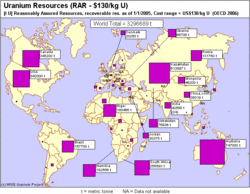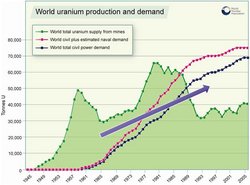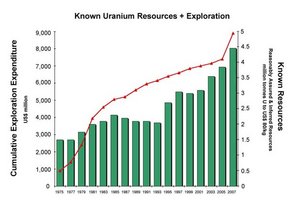Uranium supply (Energy)
Contents
Uranium supply
| Topics: |
This EOE article is adapted from an information paper published by the World Nuclear Association (WNA). WNA information papers are frequently updated, so for greater detail or more up to date numbers, please see the latest version on WNA website (link at end of article).
Introduction
High-grade ore - 2% U, 20,000 ppm U Low-grade ore - 0.1% U, 1,000 ppm U Granite 4 ppm U Sedimentary rock 2 ppm U Earth's continental crust (av) 2.8 ppm U Seawater 0.003 ppm U Uranium (Uranium supply) is ubiquitous on the Earth. It is a metal approximately as common as tin or zinc, and it is a constituent of most rocks and even oceans. Some typical concentrations are: (ppm = parts per million).
An orebody is, by definition, an occurrence of mineralization from which the metal is economically recoverable. It is therefore relative to both costs of extraction and market prices. At present, neither the oceans nor any granites are orebodies, but conceivably either could become so if prices were to rise sufficiently.
Measured resources of uranium—the amount known to be economically recoverable from orebodies—are thus also relative to costs and prices. They are also dependent on the intensity of past exploration effort, and are basically a statement about what is known rather than what is there in the Earth's crust.
Changes in costs or prices, or further exploration, may alter measured resource figures markedly. At ten-times the current price, seawater might become a potential source of vast amounts of uranium. Thus, any predictions of the future availability of any mineral, including uranium, that are based on current cost and price data and current geological knowledge are likely to be extremely conservative.
From time to time, concerns are raised that the known uranium resources might be insufficient, but our current knowledge of geology is such that we can be confident that identified resources of metal minerals are a small fraction of what is there.
Uranium availability

Current uranium (U) usage is about 68,000 t/yr. Thus the world's present measured resources of uranium in the cost category slightly above present spot prices (4.7 Mt), and used only in conventional reactors, are enough to last for some 70 years. This represents a higher level of assured resources than is normal for most minerals. Further exploration and higher prices will certainly, on the basis of present geological knowledge, yield further resources as present ones are depleted. There was very little uranium exploration between 1985 and 2005, so a significant increase in exploration effort could readily double the known economic resources, and a doubling of price from present levels could be expected to create about a ten-fold increase in measured resources over time.

This is in fact suggested in the International Atomic Energy Agency-Nuclear Energy Agency figures, if those covering estimates of all conventional resources are considered—10 million tonnes (beyond the 4.7 Mt known economic resources)—which takes us to over 200 years' supply at today's rate of consumption. This still ignores the technological factor mentioned below, and also omits unconventional resources such as phosphate deposits (22 Mt uranium recoverable as by-product) and seawater (up to 4000 Mt), which will likely remain uneconomic to extract into the foreseeable future.
Widespread use of the fast breeder reactor (FBR) could increase the utilization of uranium sixty-fold or more. This type of nuclear reactor can be started up on plutonium derived from conventional reactors and operated in closed circuit with its reprocessing plant. Such a reactor, supplied with natural uranium for its "fertile blanket", can be operated so that each tonne of ore yields 60 times more energy than in a conventional reactor.
Reactor Fuel Requirements
The world's nuclear power reactors, with combined capacity of some 370 GWe, require about 68,000 tonnes of uranium from mines (or the equivalent from stockpiles) each year. While this capacity is being run more productively, with higher capacity factors and reactor power levels, the uranium fuel requirement is increasing but not necessarily at the same rate. The factors increasing fuel demand are offset by a trend for higher burnup of fuel and other efficiencies, so demand is steady. Over the 18 years to 1993, the electricity generated by nuclear power increased 5.5-fold, while uranium use increased only just over 3-fold. It is likely that the annual uranium demand will grow only slightly to 2010.
Reducing the tails assay in enrichment reduces the amount of natural uranium required for a given amount of fuel. Reprocessing of spent fuel from conventional light water reactors also utilizes present resources more efficiently, by a factor of about 1.3 overall.
Nuclear Weapons as a source of fuel
An important source of nuclear fuel is the world's nuclear weapons stockpile. Since 1987, the United States and countries of the former USSR have signed a series of disarmament treaties to reduce the nuclear arsenals of the signatory countries by approximately 80 percent.
Nuclear weapons contain a great deal of uranium enriched to over 90 percent uranium-235, i.e., about 25-times the proportion in reactor fuel. Some weapons have plutonium-239, which can be used in diluted form in either conventional or fast breeder reactors. Since 2000, the dilution of 30 tonnes of military high-enriched uranium is displacing about 9000 tonnes of uranium oxide per year from mines, which represents about 11% of the world's reactor requirements.
Details of the utilization of military stockpiles can be found in the article Military warheads as a source of nuclear fuel.

Thorium as a nuclear fuel
Today, uranium is the only fuel supplied for nuclear reactors. However, thorium can also be utilized as a fuel for CANDU reactors or in reactors specially designed for this purpose. Neutron efficient reactors, such as CANDU, are capable of operating on a thorium fuel cycle once they are started using a fissile material such as uranium-235 or plutonium-239. Then the thorium (232Th) atom captures a neutron in the reactor to become fissile uranium (233U), which continues the reaction. Some advanced nuclear power reactor designs are likely to be able to make use of thorium on a substantial scale.
The thorium fuel cycle has some attractive features, though it is not yet in commercial use. Thorium is reported to be about three times as abundant in the Earth's crust as uranium. The 2005 IAEA-NEA "Red Book" gives a figure of 4.5 million tonnes of reserves and additional resources, but points out that this excludes data from much of the world.
Further Reading
- WNA paper on Supply of Uranium
- World Nuclear Association